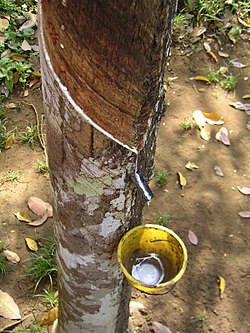Latex
From Wikipedia, the free encyclopedia
| This article does not cite any references or sources. Please help improve this article by adding citations to reliable sources (ideally, using inline citations). Unsourced material may be challenged and removed. (May 2007) |
Latex refers generically to a stable dispersion (emulsion) of polymer microparticles in an aqueous medium. Latexes may be natural or synthetic. Latex as found in nature is the milky sap of many plants that coagulates on exposure to air. It is a complex emulsion in which proteins, alkaloids, starches, sugars, oils, tannins, resins and gums are found. In most plants, latex is white, but some have yellow, orange, or scarlet latex.
The word is also used to refer to natural latex rubber; particularly for non-vulcanized rubber. Such is the case in products like latex gloves, latex condoms and latex clothing. It can also be made synthetically by polymerizing a monomer that has been emulsified with surfactants.
The term latex is attributed to Charles Marie de la Condamine, who derived it from lac, the Latin word for milk.[1]
Contents |
[edit] Sources
The cells or vessels in which latex is found make up the laticiferous system, which forms in two very different ways. In many plants, the laticiferous system is formed from rows of cells laid down in the meristem of the stem or root. The cell walls between these cells are dissolved so that continuous tubes, called latex vessels, are formed. This method of formation is found in the poppy family, in the rubber trees (Para rubber tree and Castilla elastica), and in the Cichorieae, a section of the Family Asteraceae distinguished by the presence of latex in its members. Dandelion, lettuce, hawkweed and salsify are members of the Cichorieae. It is also present in another member of the Asteraceae, the guayule plant.
In the milkweed and spurge families, on the other hand, the laticiferous system is formed quite differently. Early in the development of the seedling latex cells differentiate, and as the plant grows these latex cells grow into a branching system extending throughout the plant. In the mature plant, the entire laticiferous system is descended from a single cell or group of cells present in the embryo.
The laticiferous system is present in all parts of the mature plant, including roots, stems, leaves, and sometimes the fruits. It is particularly noticeable in the cortical tissues.
Several members of the fungal kingdom also produce latex upon injury. Notable are the milk-caps such as Lactarius deliciosus.
[edit] Natural function of latex
| This article is missing citations or needs footnotes. Please help add inline citations to guard against copyright violations and factual inaccuracies. (May 2008) |
Many plant functions have been attributed to latex. Some regard it as a form of stored food, while others consider it an excretory product in which waste products of the plant are deposited. Still others believe it functions to protect the plant in case of injuries; drying to form a protective layer that prevents the entry of fungi and bacteria. Similarly, it may provide some protection against browsing animals, since in some plants latex is very bitter or even poisonous. It may be that latex fulfills all of these functions to varying degrees in the numerous plant species in which it occurs.
[edit] Uses of latex
The latex of many species can be processed to produce other materials. Natural rubber is the most important product obtained from latex; more than 12,000 plant species yield latex containing rubber, though in the vast majority of those species the rubber is not suitable for commercial use.[2].
Balatá and gutta percha latex contain an inelastic polymer related to rubber. Latex from the chicle and jelutong trees is used in chewing gum. Poppy latex is a source of opium and its many derivatives.
Latex is also used to make gloves, catheters, condoms, and is used as a binding agent in latex paint.
[edit] Latex clothing
Latex is used in many types of clothing. Worn on the body (or applied directly by painting) it tends to be skin-tight, producing a "second skin" effect.
[edit] Allergic reactions
Some people have a serious latex allergy, and exposure to latex products such as latex gloves can cause anaphylactic shock. Guayule latex is hypoallergenic and is being researched as a substitute to the allergy-inducing Hevea latexes.
Some allergic reactions are not from the latex but from residues of other ingredients used to process the latex into clothing, gloves, foam, etc. These allergies are usually referred to as multiple chemical sensitivity (MCS).
[edit] See also
[edit] Notes
- ^ Untitled Document
- ^ Bowers, J.E. (1990). Natural Rubber-Producing Plants for the United States. Beltsville, MD: National Agricultural Library. pp. pp. 1,3. OCLC 28534889.
| Wikimedia Commons has media related to: Latex |



